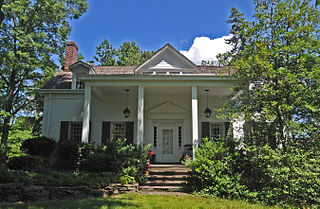
The Mohican are an Eastern Algonquian Native American tribe that historically spoke an Algonquian language. As part of the Eastern Algonquian family of tribes, they are related to the neighboring Lenape, whose indigenous territory was to the south as far as the Atlantic coast. The Mohican lived in the upper tidal Hudson River Valley, including the confluence of the Mohawk River and into western New England centered on the upper Housatonic River watershed. After 1680, due to conflicts with the powerful Mohawk to the west during the Beaver Wars, many were driven southeastward across the present-day Massachusetts western border and the Taconic Mountains to Berkshire County around Stockbridge, Massachusetts.

Pequannock Township is a township in Morris County, New Jersey, United States. As of the 2010 United States Census, the township's population was 15,420, reflecting an increase of 1,652 (+11.9%) from the 13,888 counted in the 2000 Census, which had in turn increased by 1,044 (+8.1%) from the 12,844 counted in the 1990 Census. The primary community in the township is the census-designated place of Pompton Plains.

The Ramapough Lenape Nation is a state-recognized tribe in New Jersey. They were previously named the Ramapough Mountain Indians, also known as the Ramapough Lenape Nation or Ramapough Lunaape Munsee Delaware Nation.

Lenapehoking is widely translated as 'homelands of the Lenape', which in the 16th and 17th centuries, ranged along the Eastern seaboard from western Connecticut to Delaware, and encompassed the territory adjacent to the Delaware and lower Hudson river valleys, as well as the territory between them.

The Ramapo River is a tributary of the Pompton River, approximately 30 mi (48 km) long, in southern New York and northern New Jersey in the United States.

Chief Katonah was a Lenape sachem who led both the Wiechquaeskeck band of Wappinger in the Greenwich, Stamford, and Bedford area, from whom the land of the town of Bedford, New York was purchased, and the Ramapo. The Ramapo Sachemdom was part of the Tankiteke Chieftaincy of the Wappinger League, of the Mohegan tribe of the Algonquians.
The Siwanoy were an Indigenous American band of Wappinger people, who lived in Long Island Sound along the coasts of what are now The Bronx, Westchester County, New York, and Fairfield County, Connecticut. They were one of the western bands of the Wappinger Confederacy. By 1640, their territory (Wykagyl) extended from Hell Gate to Norwalk, Connecticut, and as far inland as White Plains; it became hotly contested between Dutch and English colonial interests. The name Siwanoy may be a corruption of Siwanak, "salt people".

The Wappinger were an Eastern Algonquian Munsee-speaking Native American people from what is now southern New York and western Connecticut.

Daniel Nimham (1726–1778) was the last sachem of the Wappinger people and an American Revolutionary War combat veteran. He was the most prominent Native American of his time in the lower Hudson Valley.

Pavonia was the first European settlement on the west bank of the North River that was part of the seventeenth-century province of New Netherland in what would become the present Hudson County, New Jersey.

Bergen was a part of the 17th century province of New Netherland, in the area in northeastern New Jersey along the Hudson and Hackensack Rivers that would become contemporary Hudson and Bergen Counties. Though it only officially existed as an independent municipality from 1661, with the founding of a village at Bergen Square, Bergen began as a factory at Communipaw circa 1615 and was first settled in 1630 as Pavonia. These early settlements were along the banks of the North River across from New Amsterdam, under whose jurisdiction they fell.
Oratam was sagamore, or sachem, of the Hackensack Indians living in northeastern New Jersey during the period of early European colonization in the 17th century. Documentation shows that he lived an unusually long life and was quite influential among indigenous and immigrant populations.
Hackensack was the exonym given by the Dutch colonists to a band of the Lenape, or Lenni-Lenape, a Native American tribe. The name is a Dutch derivation of the Lenape word for what is now the region of northeastern New Jersey along the Hudson and Hackensack rivers. While the Lenape people occupied much of the mid-Atlantic area, Europeans referred to small groups of native people by the names associated with the places where they lived.

The Tappan were a Lenape people who inhabited the region radiating from Hudson Palisades and New York – New Jersey Highlands in at the time of European colonialization in the 17th century.

The Esopus tribe was a tribe of Lenape (Delaware) Native Americans who were native to the Catskill Mountains of what is now Upstate New York. Their lands included modern-day Ulster and Sullivan counties.
TaphowTAP-hoh was a Native American Munsee sachem in Connecticut, was the son of Ponus and the uncle to Katonah. Taphow, known as the "Sakimore and Commander in Chief of all those Indians inhabiting in northern New Jersey, signed many land deeds "in the lands of Taphow and his relations" including the Ramapo Tract in 1700, the Kakiat Patent in 1701 and witnessed the sale of the Wawayanda Patent. Taphow's wife, Awowas (Wawowus), and son Quatowquechuck also signed on some land deeds. Taphow was accused of murder in Connecticut but was acquitted for lack of evidence.
The Munsee or mə́n'si·w are a subtribe of the Lenape, originally constituting one of the three great divisions of that nation and dwelling along the upper portion of the Delaware River, the Minisink, and the adjacent country in New York, New Jersey, and Pennsylvania. From their principal totem they were frequently called the Wolf tribe of the Lenape. They were considered the most warlike portion of their nation and assumed the leadership in war councils. They were prominent in the early history of New York and New Jersey, being among the first nations of that region to meet the European colonizers.









